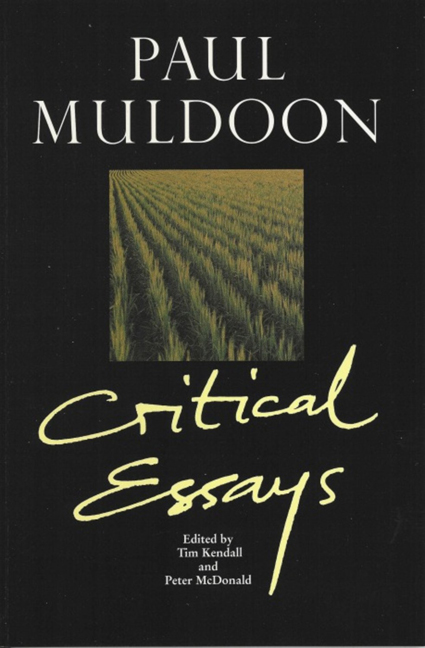Book contents
- Frontmatter
- Contents
- Acknowledgements
- Notes on Contributors
- Introduction
- ‘Thirteen or Fourteen’: Paul Muldoon's Poetics of Adolescence
- Never Quite Showing his Hand: Robert Frost and Paul Muldoon
- For Father Read Mother: Muldoon's Antecedents
- Pax Hibernica/Pax Americana: Rhyme and Reconciliation in Muldoon
- Muldoon and Pragmatism
- ‘All That’: Muldoon and the Vanity of Interpretation
- Paul Muldoon's Transits: Muddling Through after Madoc
- ‘All Art is a Collaboration’: Paul Muldoon as Librettist
- Muldoon's Remains
- Index
Never Quite Showing his Hand: Robert Frost and Paul Muldoon
- Frontmatter
- Contents
- Acknowledgements
- Notes on Contributors
- Introduction
- ‘Thirteen or Fourteen’: Paul Muldoon's Poetics of Adolescence
- Never Quite Showing his Hand: Robert Frost and Paul Muldoon
- For Father Read Mother: Muldoon's Antecedents
- Pax Hibernica/Pax Americana: Rhyme and Reconciliation in Muldoon
- Muldoon and Pragmatism
- ‘All That’: Muldoon and the Vanity of Interpretation
- Paul Muldoon's Transits: Muddling Through after Madoc
- ‘All Art is a Collaboration’: Paul Muldoon as Librettist
- Muldoon's Remains
- Index
Summary
In 1985, the poet Michael Donaghy interviewed Paul Muldoon for the Chicago Review. Towards the end of the interview the two consider why, in recent decades, a number of Irish poets have looked to America for inspiration. Muldoon's explanation is that ‘in terms of writing it seems to me that a lot of exciting things have happened here’ – and he then declares that ‘One of my favorite poets is Robert Frost’. Donaghy notes that ‘You've mentioned Frost in other interviews, and so has Seamus Heaney. In a way it seems to suggest that you two see more going on in Frost than a lot of Americans do.’ Muldoon's response: ‘Well, I think Frost is partly to blame for that.’ The connections between Seamus Heaney and Robert Frost are arguably quite obvious, even on a casual reading of the two poets’ work – as Heaney explains in his Nobel lecture, ‘I loved Robert Frost for his farmer's accuracy and his wily down-to-earthness’, and these same qualities are perceptible in Heaney's own poetry. With Frost and Muldoon, however, the similarities at first seem far less convincing. On the surface, much of Muldoon's poetry appears to be more cerebral, more obscure, perhaps in some ways more difficult, than either Frost's or Heaney's. Yet, despite the fact that the influence has taken a different form, Frost's impact on Muldoon has been no less considerable than it has been on Heaney.
Muldoon was introduced to Frost's poetry in the early 1960s, at about the age of eleven, by Gerard Quinn, who was his teacher at St Patrick's College, Armagh. It is evident that Quinn's reading of Frost profoundly affected Muldoon's own attitude to the American poet: in the interview with Donaghy he remarks that, when talking about Frost, he is still ‘to some extent reflecting the ideas of my friend Gerard Quinn’. Muldoon has written a poem about this early encounter with Frost's poetry, and about Quinn's influence on his reading of Frost.
- Type
- Chapter
- Information
- Paul MuldoonCritical Essays, pp. 26 - 44Publisher: Liverpool University PressPrint publication year: 2004



